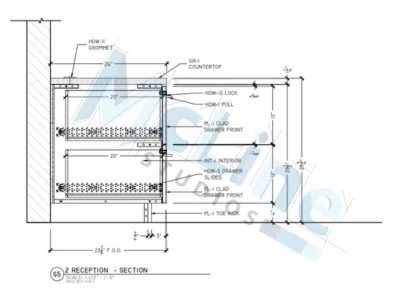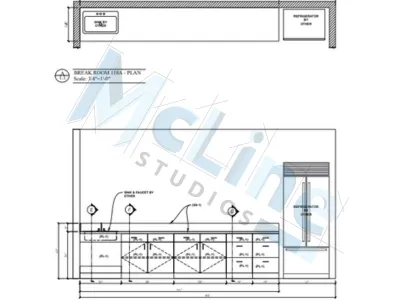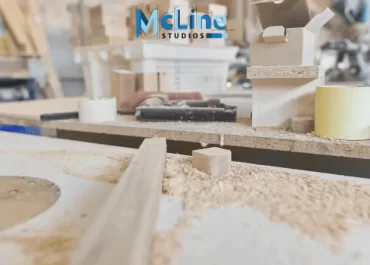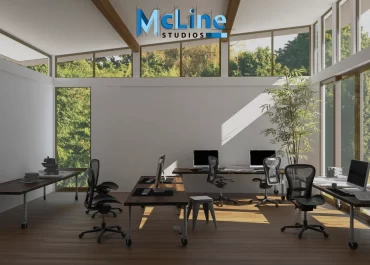Millwork shop drawings serve as the blueprint for precision in architectural woodworking projects. These detailed documents are essential for ensuring accurate fabrication and installation of millwork elements, such as cabinetry, molding, and trim.
Key components of millwork shop drawings include precise measurements, material specifications, joinery details, and assembly instructions. These drawings not only communicate the design intent but also provide critical information for manufacturers, carpenters, and installers to follow.
Each drawing typically includes comprehensive views, such as elevations, sections, and plans, showcasing the dimensions and intricacies of the millwork. Additionally, annotations and callouts clarify specific details, ensuring clarity and accuracy throughout the fabrication process. In this blog, we will learn more about the basics and essential details of millwork shop drawings.

What Does Millwork Shop Drawings Mean?
Millwork shop drawings are detailed diagrams or plans created by architects or drafters to communicate specific design instructions for custom millwork components. These drawings provide precise measurements, materials specifications, and assembly details for items like cabinets, doors, windows, and trim pieces.
Millwork refers to woodwork or other building materials produced in a mill. This can include items such as doors, windows, trim, molding, crown molding, baseboards, and other decorative elements used in construction or interior design. Generally, millwork shop drawings include elevation views, cross-sections, and other technical illustrations to convey the intricacies of the design.
Millwork shop drawing documents are essential for coordinating between designers, architects, and craftsmen, facilitating smooth production processes, and ensuring the final product meets the desired aesthetic and functional requirements.
What Is Included In Millwork Shop Drawings?
Millwork shop drawings are typically created by specialized expert draftsmen, architects, or designers, and serve as a crucial communication tool between design professionals, manufacturers, and contractors. Key details found in millwork shop drawings include:
- Dimensional Information: Accurate dimensions are essential to ensure that the millwork components fit precisely within the intended space. This includes overall dimensions as well as detailed measurements for individual components such as panels, moldings, and trim.
- Material Specifications: The type of wood or other materials used for the millwork components must be specified in the drawings. This includes details such as wood species, grade, finish, and any special treatments or coatings required.
- Joinery and Assembly Details: Millwork often involves complex joinery techniques to create seamless connections between components. Shop drawings provide detailed illustrations of how each piece is to be assembled, including the type of joints (e.g., dovetail, mortise, and tenon) and fasteners (e.g., screws, dowels) to be used.
- Profiles and Mouldings: Millwork often features intricate profiles and moldings that add decorative detail to architectural elements such as doors, windows, and cabinetry. Shop drawings specify the exact profiles and dimensions of these moldings to ensure consistency and accuracy in fabrication.
- Hardware and Accessories: Drawings may include specifications for hardware such as hinges, handles, knobs, and locks, as well as any other accessories required for installation or functionality.
- Cutting Lists: To optimize material usage and minimize waste, shop drawings may include cutting lists that specify the dimensions and quantities of each component to be cut from raw materials such as lumber or sheet goods.
- Elevations and Sections: Elevations and cross-sectional views provide additional detail on the appearance and construction of millwork components, showing how they relate to other elements within the space.
- Assembly Instructions: Detailed instructions may be provided to guide the assembly and installation of complex millwork components, particularly for projects with unique or specialized requirements.
- Finish Schedule: If different finishes are required for various millwork components, a finish schedule may be included in the drawings, specifying the type of finish (e.g., stain, paint, varnish) and any special instructions for application.
- Annotations and Notes: Annotations and notes throughout the drawings provide important information and clarifications regarding specific details, materials, or construction methods.
What Drawings Are Typically Included In Standard Millwork Submittal?

Millwork submittal typically includes a variety of drawings to communicate design, dimensions, materials, and other pertinent information to clients, architects, engineers, and contractors. Some common types of drawings included in millwork submittals are:
- Shop Drawings: These are detailed drawings produced by the millworker or subcontractor that illustrate how the millwork items will be fabricated and installed. They include dimensions, materials, joinery details, hardware specifications, and any other relevant information.
- Elevations: Elevations show the vertical view of the millwork, indicating the height, width, and depth of each component. They provide a clear visual representation of how the millwork will look when installed against walls or within a space.
- Plans: Plans provide a top-down view of the millwork layout within a space. They show the arrangement of cabinets, shelves, countertops, and other elements, helping to ensure proper fit and functionality.
- Sections: Sections are cut-through views of the millwork assemblies, showing details such as construction methods, materials, and connections. They provide insight into how different components come together and interact.
- Details: Detail drawings zoom in on specific areas of the millwork to provide close-up views of joints, connections, moldings, and other intricate features. These drawings ensure that all elements are accurately represented and constructed.
- Finish Schedules: Finish schedules specify the type of finishes to be applied to different millwork components, including paints, stains, varnishes, or laminates. They may include color swatches or reference codes for easy identification.
- Hardware Schedules: Hardware schedules list all the hardware items to be used in the millwork, such as hinges, handles, drawer slides, and locks. They provide details such as manufacturer, model number, finish, and quantity required.
Final Thoughts
In summary, the importance of millwork shop drawings cannot be overstated if you are in woodworking and construction. These intricate blueprints serve as the roadmap for bringing intricate designs to life, ensuring precision, accuracy, and adherence to specifications.
Through precise attention to detail, including dimensions, materials, joinery techniques, and finishes, shop drawings provide a crucial foundation for successful woodworking project execution.




